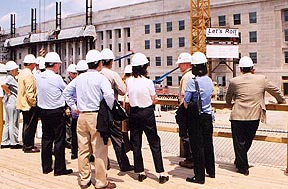 About ACHP
About ACHP ACHP News
National Historic
Preservation
Program
Working with
Section 106
Federal, State, & Tribal Programs
Training & Education
Publications
Search
Home
ACHP Continues New Direction at Spring Business Meeting
Members Advance Issues Presented by Committees
Using its newly adopted format, the Advisory Council on Historic Preservation (ACHP) held its spring business meeting May 31, 2002, in Washington, DC. Under the new meeting structure, the agency's three standing committees— Federal Agency Programs, Preservation Initiatives, and Communications, Education, and Outreach—advanced a number of issues, which were discussed or approved by the full Council membership (see specific committee issues below).
Members also received an update on ACHP's proposed Executive order on preserving America's heritage, which is currently under review by the Office of Management and Budget. In addition, members adopted a new mission statement that better reflects ACHP's new direction in the national historic preservation program: "The Advisory Council on Historic Preservation promotes the preservation, enhancement, and productive use of our Nation's historic resources, and advises the President and Congress on national historic preservation policy."
During the meeting, representatives from the Pentagon Renovation Program gave a presentation on their progress rebuilding the section of the U.S. military headquarters that was most severely damaged during the September 11, 2001, terrorist attack. Several members and staff later toured the site for a firsthand look at the renovation.
 ACHP members tour the area of the Pentagon that
was damaged during the September 11, 2001, terrorist attacks on the U.S.
The renovations are scheduled for completion September 11, 2002. (staff
photo)
ACHP members tour the area of the Pentagon that
was damaged during the September 11, 2001, terrorist attacks on the U.S.
The renovations are scheduled for completion September 11, 2002. (staff
photo)
Federal Agency Programs Activities
ACHP members formally approved an initiative put forth by the Federal Agency Programs Committee that allows the Army to streamline its management of historic Cold War era housing known as Capehart and Wherry era housing. The streamlining, achieved through an ACHP program comment, allows the Army to consider the treatment of certain historic properties on an Army-wide basis instead of case by case. In light of the Army's current plan to upgrade much of its housing, this initiative is estimated to save more than $5.5 million. [Read more on this streamlining initiative]
 ACHP Chairman Nau (seated) signs a program comment
that approves the Army's future management of its Capehart and Wherry
Era housing. Standing from left to right are Philip W. Grone, ACHP member
designee for Department of Defense; Col. Richard A. Hoefert, Director
of Environmental Programs, Office of the Assistant Chief of Staff for
Installation Management; and Raymond J. Fatz, Army Federal Historic Preservation
Officer
ACHP Chairman Nau (seated) signs a program comment
that approves the Army's future management of its Capehart and Wherry
Era housing. Standing from left to right are Philip W. Grone, ACHP member
designee for Department of Defense; Col. Richard A. Hoefert, Director
of Environmental Programs, Office of the Assistant Chief of Staff for
Installation Management; and Raymond J. Fatz, Army Federal Historic Preservation
Officer
(staff photo)
In addition, the committee reported on the opportunity to improve coordination between Section 4(f) of the Department of Transportation Act and Section 106 of the National Historic Preservation Act. While both laws are intended to consider effects of Federal undertakings on properties listed in the National Register of Historic Places, Section 4(f) requires that the Federal Highway Administration consider project alternatives that will completely avoid historic properties or cause the least harm. Section 106, on the other hand, is a consultative process that provides for negotiation of outcomes that could allow the project to go forward even when the historic property may be adversely affected.
Preservation Initiatives Activities
Members endorsed in concept the Preservation Initiatives Committee's "Preserve America" program, intended to encourage public and private partnerships to preserve—and actively use—our country's historic and cultural heritage in ways that will help sustain the future of communities and foster an appreciation of America's history and cultural diversity.
Members also approved the development of a study by ACHP's Preservation Initiatives staff on the current effectiveness of Federal preservation funding and on future Federal preservation funding needs. Staff was also directed to work with the Department of Agriculture as it implements conservation and preservation elements of the newly passed Farm Bill.
Communications, Education, and Outreach Activities
Members discussed ACHP's draft communications plan, and approved a plan and schedule put forth by the Communications, Education, and Outreach Committee for a 2002 award for an exemplary Federal partnership in historic preservation. The award, which will be jointly administered by ACHP and the National Trust for Historic Preservation, will be presented at the National Trust's National Preservation Award Ceremony in Cleveland, OH, in October 2002.
About the Members
John Nau, III, of Houston, Texas, chairs ACHP, whose membership includes four historic preservation experts, four citizen members, a Native Hawaiian, a governor, a mayor, and four Federal agency heads, all appointed by the President. The Secretaries of the Interior and Agriculture, the Architect of the Capitol, the president of the National Conference of State Historic Preservation Officers, and the chairman of the National Trust for Historic Preservation round out the membership. John M. Fowler serves as Executive Director. ACHP is headquartered in Washington, DC, with an office in Denver, CO.
Posted
June 5, 2002